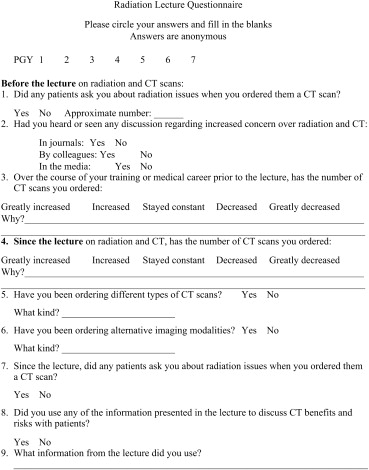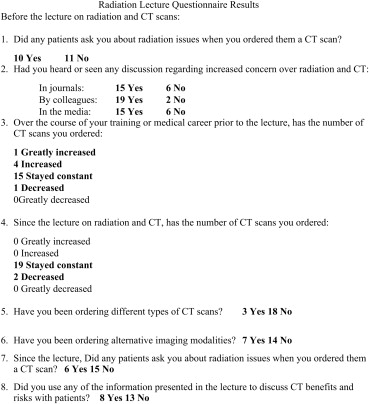Rationale and Objectives
The aim of this study was to determine if educating residents about the potential effects of radiation exposure from computed tomographic (CT) imaging alters ordering patterns. This study also explored whether referring physicians are interested in radiation education and was an initial effort to address their CT ordering behavior.
Materials and Methods
Two to four months after a radiologist’s lecture on the potential effects of radiation exposure related to CT scans, urology and orthopedic residents were surveyed regarding the number and types of CT scans they ordered, the use of alternative imaging modalities, and whether they used the lecture information to educate patients.
Results
Twenty-one resident lecture attendants completed the survey. The number of CT scans ordered after the lecture stayed constant for 90% (19 of 21) and decreased for 10% (two of 21). The types of CT scans ordered changed after the lecture for 14% (three of 21). Thirty-three percent (seven of 21) reported increases in alternative imaging after the lecture, including 24% (five of 21) reporting increases in magnetic resonance imaging and 19% (four of 21) reporting increases in ultrasound. Patients directed questions about radiation exposure to 57% (12 of 21); 38% (eight of 21) used the lecture information to educate patients. Referring physicians were interested in the topic, and afterward, other physician groups requested radiation education lectures.
Conclusions
Most clinicians did not change their CT scan ordering after receiving education about radiation from a radiologist. Radiation education allowed clinicians to discuss CT benefits and risks with their patients and to choose appropriate CT protocols. Referring physician groups are interested in this topic, and radiologists should be encouraged to give radiation lectures to them.
In the past few years, there has been increased public health concern regarding the effects of radiation exposure from computed tomographic (CT) scans to the US population, both in the radiology literature as well as in other medical specialty journals . Media outlets, including print, online, and television sources, have brought this issue into the public spotlight, for example in the New York Times series of articles entitled “The Radiation Boom”, beginning in January 2010 . The number of CT scans performed has rapidly increased over the past few decades for numerous reasons. CT scans can provide rapid, accurate diagnoses in many patients, and CT scans can assess responses to therapies, leading to longer, higher quality lives . However, the possibility of overutilization or inappropriate utilization of CT scans is concerning to physicians, the public, and the government . Physicians and the public are concerned about the estimated increased risk for malignancy induced by radiation from CT scans, and the US government is also trying to guide new policy as well as control rising health care costs .
Radiologists have been addressing CT scan radiation risk for years. A white paper on radiation dose in medicine published in 2007 in the Journal of the American College of Radiology proposed 37 goals to decrease the amount of radiation exposure to the population from medical imaging . As of the fall of 2010, 30 of these 37 goals have been completed or are in progress . The Image Gently campaign begun by pediatric radiologists, and the new Image Wisely campaign by the American College of Radiology (ACR) and Radiological Society of North America that focuses on adults, are designed to decrease radiation dose from medical imaging to the US population by optimizing CT scan protocols at imaging facilities and educating radiologists, clinicians, and patients about exam appropriateness and radiation issues .
Get Radiology Tree app to read full this article<
Get Radiology Tree app to read full this article<
Materials and methods
Get Radiology Tree app to read full this article<
Get Radiology Tree app to read full this article<
Get Radiology Tree app to read full this article<
Get Radiology Tree app to read full this article<
Results
Get Radiology Tree app to read full this article<
Get Radiology Tree app to read full this article<
Get Radiology Tree app to read full this article<
Get Radiology Tree app to read full this article<
Get Radiology Tree app to read full this article<
Get Radiology Tree app to read full this article<
Get Radiology Tree app to read full this article<
Get Radiology Tree app to read full this article<
Get Radiology Tree app to read full this article<
Get Radiology Tree app to read full this article<
Get Radiology Tree app to read full this article<
Get Radiology Tree app to read full this article<
Discussion
Get Radiology Tree app to read full this article<
Get Radiology Tree app to read full this article<
Get Radiology Tree app to read full this article<
Get Radiology Tree app to read full this article<
Get Radiology Tree app to read full this article<
Get Radiology Tree app to read full this article<
Get Radiology Tree app to read full this article<
Get Radiology Tree app to read full this article<
Get Radiology Tree app to read full this article<
Get Radiology Tree app to read full this article<
Get Radiology Tree app to read full this article<
Conclusions
Get Radiology Tree app to read full this article<
References
1. Berrington de Gonzalez A., Mahesh M., Kim K.P., et. al.: Projected cancer risks from computed tomographic scans performed in the United States in 2007. Arch Intern Med 2009; 169: pp. 2071-2077.
2. Smith-Bindman R., Lipson J., Marcus R., et. al.: Radiation dose associated with common computed tomography examinations and the associated lifetime attributable risk of cancer. Arch Intern Med 2009; 169: pp. 2078-2086.
3. Sodickson A., Baeyens P.F., Andriole K.P., et. al.: Recurrent CT, cumulative radiation exposure, and associated radiation-induced cancer risks from CT of adults. Radiology 2009; 251: pp. 175-184.
4. Bogdanich W. Radiation Offers New Cures, and Ways to Do Harm. The New York Times January 24, 2010.
5. Hendee W.R., Becker G.J., Borgstede J.P., et. al.: Addressing overutilization in medical imaging. Radiology 2010; 257: pp. 240-245.
6. Broder J., Warshauer D.M.: Increasing utilization of computed tomography in the adult emergency department 2000-2005. Emerg Radiol 2006; 13: pp. 25-30.
7. Redberg R.F.: Cancer risks and radiation exposure from computed tomographic scans: how can we be sure that the benefits outweigh the risks?. Arch Intern Med 2009; 169: pp. 2049-2050.
8. Keehan S., Sisko A., Truffer C., et. al.: Health spending projections through 2017: the baby-boom generation is coming to Medicare. Health Aff (Millwood) 2008; 27: pp. w145-w155.
9. Amis E.S., Butler P.F., Applegate K.E., et. al.: American College of Radiology white paper on radiation dose in medicine. J Am Coll Radiol 2007; 4: pp. 272-284.
10. Amis E.S., Butler P.F.: ACR white paper on radiation dose in medicine: three years later. J Am Coll Radiol 2010; 7: pp. 865-870.
11. Brink J.A., Amis E.S.: Image Wisely: a campaign to increase awareness about adult radiation protection. Radiology 2010; 257: pp. 601-602.
12. Sidhu M.K., Goske M.J., Coley B.J., et. al.: Image gently, step lightly: increasing radiation dose awareness in pediatric interventions through an international social marketing campaign. J Vasc Interv Radiol 2009; 20: pp. 1115-1119.
13. National Research Council Committee to Assess Health Risks from Exposure to Low Level of Ionizing Radiation. Health risks from exposure to low levels of ionizing radiation: BEIR VII, Phase 2.2006.National Academies PressWashington, DC
14. Townsend B.A., Callahan M.J., Zurakowski D., et. al.: Has pediatric CT at children’s hospitals reached its peak?. AJR Am J Roentgenol 2009; 194: pp. 1194-1196.

